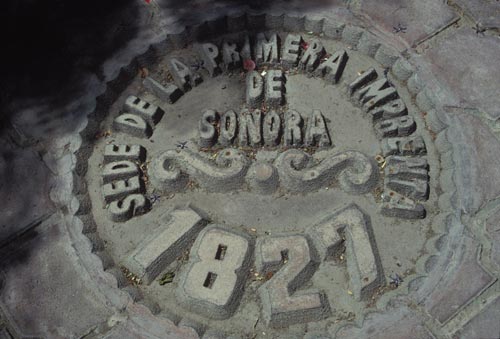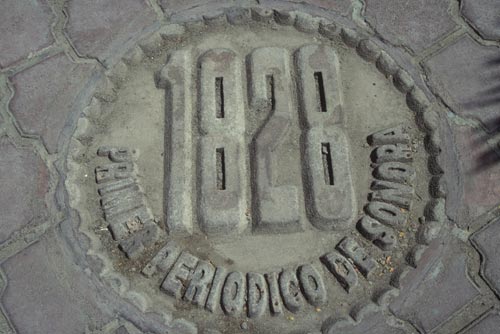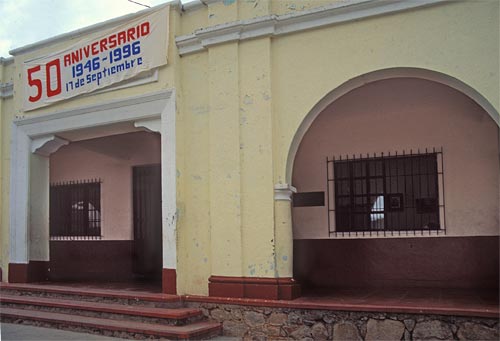The 1800’s were turbulent time for Mexico, Sonora and Álamos.
The faded heydays of Álamos silver and trading wealth were in the past.
Confrontation was at the forefront along the northern frontier.
1850
Hermosilo connected to the port of Guaymas.
1850’s
Military colonies and settlements are encouraged on the northern border
to help stop marauding Apaches. Free border land was offered to
Mexicans and anyone else except for Americans and Indians. These plans
were not successful. The government also was offering a bounty for
Apache scalps.
1850 – 1880
Population estimates of 5,000.
1853
December – “Tratado (Treaty) de Mesilla”, the Gadsen purchase was
signed between Mexico and the United States. Sonora was paid ten
million dollars for land including having its northern boundary cut
back to its present border. This allowed the United States to build a
southern transcontinental route.
1854
The Gadsen purchase is ratified by Mexico and The United States.
1854
Charles D. Poston, was shipwrecked in the Gulf of california and
visited Álamos. He would become known as the “Father of Arizona.” He
recalled his visit in an account told to J. Ross Browne: “In about a
week from the time of leaving the seacoast we reached the old city of
Alamos, famous in Spanish times for its wealth and commercial
enterprise. The cathedral is very fine, and yet bears the Royal Arms
of Spain over the grand entrance. The merchants of Alamos used to
import directly from China, and had a large trade with the smaller
towns of Sinola and Sonora, but its principal source of wealth was the
rich silver mines in the spur of the Sierra Madre, which were worked
with great profit when cheap labor could be obtained from the native
Indians under the system of peonage adopted and endorsed by the
Spanish government.”
Álamos seemed like ” a quiet old town” to Mr. Poston.
1855
The Centralist’s reign came to an end with the fall of dictator Santa
Anna. “Church against State” remains a political contention in Álamos.
1855
The school Seminario Angol-Español changed it name to Liceo de Sonora.
1855 – 1861
“The War of Reform” was a civil war against the “Ley (Law) Juarez” and
other reform laws initiated by Benito Juarez and supported by
Liberals, reform party members, that took land and power away from the
church. The reforms were opposed by the Conservatives – church party
members. War took place in across Sonora and into Sinaloa, Álamos was
in the middle of many events. The Conservatives were led by Don Jesus
Gandara. The Liberals were led by general Ignacio Pesqueira
and were attempting to uphold the new f ederal laws.
1857
August – General Pesqueria becomes Sonora’s Governor.
1857
Late in the year Gandara led an southern attack along with the Yaquis
that was met by troops from Álamos. Gandara was defeated and
retreated to the Yaqui river. From here he continued attacks
in the north.
1858
Pesqueria stops in Álamos on his way south to help the Liberals in
Sinola. Pesqueria gives Álamos special authority in case of
emergencies. He also recruits men in Álamos and El Fuerte
to join his cause.
1859
Apaches from the north reached the Álamos district. Haciendas
and villages are left in ruin.
1859
Álamos mayor, Manuel Salazar, bargains a peace treaty with
the Indians and there is an ensuing calm for a short period.
1860
Álamos floods.
1861
Professor Gregorio Almada leaves Liceo de Sonora for Mazatlan
and the school is closed.
1861
August – Conservatives under the command of Don Antonio Esteves
advance from El Fuerte on the El Camino Real and defeat National
Guard troops and armed citizens from Álamos some of whom join the
Conservatives. The conservatives march untested in a welcoming
Álamos. Don Toribio Almada, the 21 year old son of Don Jose Maria
joins up with Don Antonio Esteves, becomes second-in-command, and
vow to defeat Ignacio Pesqueira.
1861
October 15 – Pesquiera defeats Esteves / Alamda in Hermosilo.
Pesquierq and General Placido Vega punish Álamos citizens supporting
the Conservatives. Vincente Almada, a son of Don Jose Maria was put
to death. Toribio Almada escapes to Chihuahua.
1861
Álamos is retaken by Liberal General Plácido Vega.
Governor Pesquiera returns to meet with Vega in Álamos.
Pesquiera felt many Álamos citizens were major supporters
of the Conservatives and he takes their property as punishment.
He has a captured Toribio Almada returned to Álamos to be
executed in the cemetery by firing squad.
1861 – 1862
December – January – French troops land on the coast of Vera Cruz.
Mexico taxes the country to raise money to fight the French.
Most of mexico was against the French invaders but some
Conservatives became French allies. Governor Pesquiera prepares
to defend Sonora from the French by building his National Guard.
He also had to fight the Apaches who were now stronger because
American troops in the southwest were now involved with the
American Civil War.
1862
May – A club is formed in Álamos to raise money for the
federalists to defeat the French. At the same time there
are those with 1mperialistic leanings in support of the French.
News from the south was of interest to all of Álamos.
1863
Apaches reach the edge of Álamos and kill people
and ruin property.
1863
June – Mexico City falls to the French.
1864
Maximilian is made Emperor of Mexico.
1864
Another mint opens in Alamos which produced silver and
gold coins and closed in 1895. (Note, a later statement
contradicts the 1864 date and uses 1861. 1861 probably
is correct since there was a failure of Alamos to report
to Mexico City during the days of Maximillian by most of the
mints in Mexico. (Information from ‘The Mexican Mints of Alamos
and Hermosillo’, by A.F.’Pradeau, 1934)
1865
Early – French troops land in Guaymas.
1865
August 28 – French troops from Guaymas take over the plaza
in Álamos. Colonel Jose Tranquilino Almada was put in command
and had an additional 1500 Yaquis and Mayos join his forces.
Álamos saw an increase in wealth as several mines were operating again
and there was a business boom. But this would not last for long.
During the French reign Sonora was divided into three Imperial
Departments with capitals in Altar, Urea and Álamos.
1865
September 22 – General Antonio Rosales, with less than 500 troops,
leaves El Fuerte to recapture Álamos from the French Imperialists.
Rosales forces met Colonel Almada’s larger force in a three hour
battle on Guadalupe Hill. Rosales and many of his men, possibly a
third, were killed. Rosales was buried in the Álamos cemetery.
His body was later moved to Mexico City.
1865
Emperor Maximilian declares Álamos capital of the department of Álamos.
1866
January 7 – Álamos is attacked by General Angel Martinez.
Colonel Jose Maria Tranquilino Almada leads the Imperialist and
retreats to the plaza where he is defeated and escapes to the mayo
River. Second-in-command Antonio Anselmo Alamda is one of many
Imperialists to die in the battle. General Angel Martinez, a ruthless
veteran of wars, plunders all the precious metals in the church and
wreaks havoc on the town taking what he wanted and leaving little
behind except for strong troops to hold the town.
1866
Don Jose Maria Almada dies. He was married twice and had
at least 31 children.
1866
May 31 – Colonel Almada attacks Colonel Adolfo Palecio troops
in Minas Nueva. Colonel Almada is defeated.
1866
August 28 – After holding Álamos for a couple of weeks
Colonel Almada is forced to abandon city by Colonel Adolfo Palecio.
1866
September 14 -15 – The French garrison on Guaymas is abandoned after
several defeats in central Sonora. Governor Ignacio Pesqueira, low on
money, Indians and enemies on the attack and floods, now had to
attempt to unify Sonora.
1866
September – Sonora returns to the republic of Mexico.
1867
February – French troops leave Mexico.
1867
June – Emperor Maximilian is executed.
1867
July – Mexico is again independent. President Juarez returns
to mass celebrations in Mexico City.
1869
October – 50 people died and over 100 homes in the Alameda
section were destroyed by floods at daybreak. All of southern
Sonora were effected by the Yaqui, Mayo and El Fuerte rivers
overflowing their banks.
(There are other accounts that indicate the flood was in 1868.)
1870’s – 1880’s
Yaqui Cajeme, ( Jose Maria Leyva), leads Indian raids and highway robberies.
1871
“Plan de la Noria” proclaimers occupy Álamos. They were opposed to
President Juarez and favored Porfirio Diaz. They collected $45,000
peso and recruited troops to join them as they headed north.
They would lose.
1872
Early – Governor Pesqueira’s troops visit Álamos enroute to
Sinoloa. As most advancing forces did, whether headed north or
south, Pesqueira demanded, and received money to fund his campaign,
in this case he withheld funds intended for Álamos.
1872
Ignacio Pesqueira is reelected Governor of Sonora. álamos, which
for the most part did not like Ignacio Pesqueira stage civil
unrest – “the Plan of the Promontorios”.
1872 – 1873
There are hostilities between Sonoran legislative and executive
branches over the new state constitution. Álamos District
has many citizens opposed to Governor Pesqueira.
1873
November – Carlos Conant, leading the “the Plan of the Promontorios”,
with 400 men and opposed to Governor Pesqueira, takes over Álamos.
He receives $36,000 pesos from local merchants. He creates problems
for
Sonora for couple of months.
1875
Álamos leads Independents in revolt against Pesqueira.
1875
Colonel Jose J. Pesqueira, nephew of Don Ignacio, was elected
Governor of Sonora in a controversial election where ballots from
districts that voted against Pesqueira were discarded by the
legislature. Several areas of the state, along with Álamos,
revolted and a civil war started.
1876
February 8 – Governor Jose Pesqueira occupies Álamos. He demands
$72,000 pesos and creates harsh laws and demanded loans from wealthy
citizens, loans he had no intention of repaying. Many citizens fled
for safety in Sinaloa. Pesqueira jailed people who did not obey his
wishes. Travel in and out of Álamos now required passports. People
were upset and rebelled.
1876
March 1 – The Federal government had General Vicente Mariscal land
troops in Guaymas to restore order. He arrived in Álamos to confer
with Governor Jose Pesqueira in the Plaza de las Armas. Pesqueira
left Álamos on March first and returns to Hermosillo.
1878
April – More controversy in the Sonora legislature: Governor
Mariscal and Vice-Governor Francisco Serna are in opposition
to each other. each has their own factions.
1879
February – Francisco Serna, in opposition to Mariscal, invades and
controls Álamos. Serna, while in Álamos, is declared Governor by
his faction in the legislature. Mariscal, deciding against more
civil war in Sonora leaves Hermosillo before Serna returns.
1881
Primary education became compulsory where schools existed.
1882
Mayos are on the attack. They are joined by Yaquis.
Navajo is deserted with many leaving for protection in Álamos.
Navajo is now a military outpost. The National Guard
arrived to fortify Navajoa.
1882
There was a major battle outside Navjoa at nearby Rancho Capetmaya.
The battle was a stalement with the Indians retreating to the hills
and rivers and the National Guard seeking protection in Álamos and
surrounding towns.
1882
Railway connects Nogales with Guaymas. The State of Sonora is
raising money to benefit public education.
1883
Álamos is preparing for Indian attacks. Álamos merchants
ask that more federal troops be stationed in
Navajoa for protection.
1884
13 mining firms are operating 15 mines which employ 750 workers.
Many old mines are shut down and others are in bad repair.
1885 – 1886
Cajeme leads 3,000 to 4,000 Yaquis and Mayo warriors.
1886
Telegraph is connected to Álamos. A new city jail is built on
Loma de Guadalupe and the Plaza de las Armas is renovated.
1887
April – Cajeme is captured and executed.
1887
A hospital for the poor is donated to Álamos by Justina Almada de
Urrea. It will continue to operate until 1946.
1888
Sonora is improving mining and agricultural districts roads.
Estacion Baramotal near Guaymas is connected by stage line
to Álamos and the old stage line from Álamos to El Fuerte.
1888
Vice- Governor Ramon Corral, born in the Álamos district, comes
to Álamos for a monthand appoints a public education committee
of 15 and provides provide state money for Álamos public education.
1895
December – Governor Ramon Corral attends the opening of the
new Álamos water system. The city now has access
to running water.
1897
Early May – A peace settlement between The Indians and
non-Indians was negotiated and agreed to. The peace treaty
signing was a festive event.
1899
The peace settlement between Indians and “Yoris”, whites,
was broken by the Yaquis. Mexico’s President Diaz had federal
troops push back at the Indians to allow the State of Sonora to function with more peaceful times. Yaguis villages were burned
and the federal troops kept pressure on the Yaguis and drove
many across the border into Arizona. less fortunate Yaguis
were sent to Yucatan slave camps.
More to come…
♦ Other Álamos, Sonora Mexico timelines:
This is a work in progress.
If you have additional dates and events send a comment
To see more Alamos Journal pages.
To return Home.
©2014 Anders Tomlinson, all rights reserved.

























